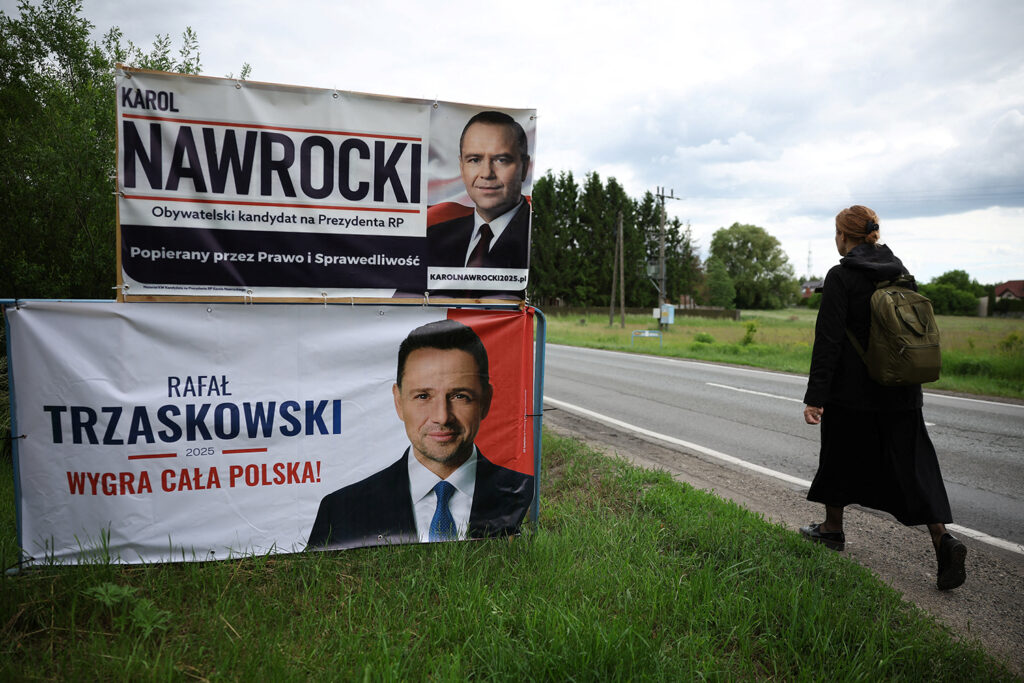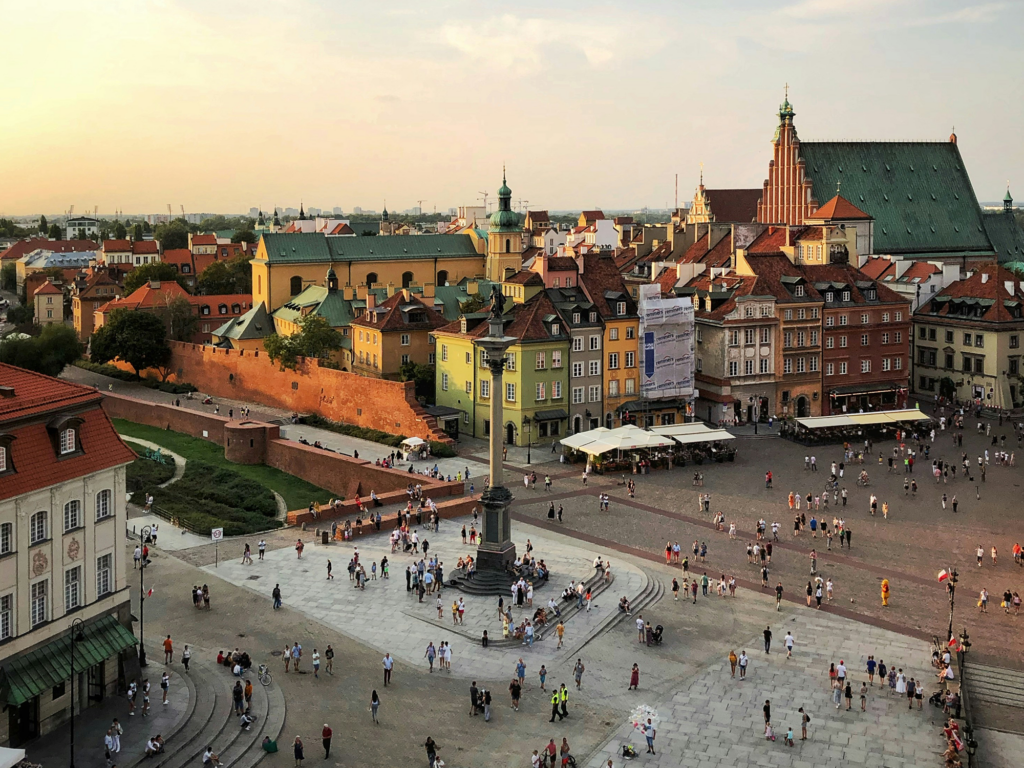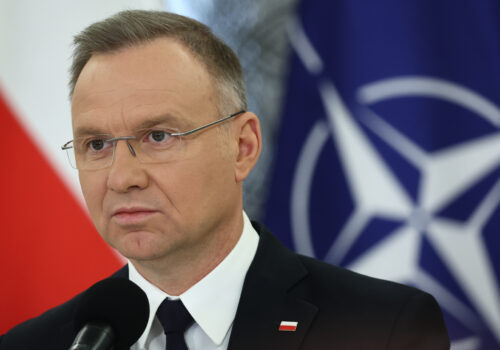Poles will vote for their next president on June 1. Depending on the outcome, this election could kick off a period of political stability—or further cement a gridlock that could lead to the government collapsing.
In the October 2023 parliamentary elections, current Prime Minister Donald Tusk’s center-right Civic Coalition (KO) ended eight years of rule by the national-conservative Law and Justice (PiS) party and formed a broad government consisting of centrists, liberals, socialists, and greens.
However, Tusk does not command a three-fifths majority in the Sejm (the lower house of parliament), which is needed to override any potential presidential veto. President Andrzej Duda, formally from PiS, has delayed or blocked many of the prime minister’s domestic legislative reforms. But now, Duda’s two terms are up.
Two candidates will face off in a final round: Rafał Trzaskowski, the mayor of Warsaw from KO, and Karol Nawrocki, head of the Institute for National Remembrance, who is tied to PiS.
Ahead of the second round, Aaron Korewa, director of the Atlantic Council’s Warsaw Office, breaks down the race and the potential impacts on Poland’s foreign policy.
How has the race unfolded so far?
The Poles voted in the first round on May 18. Trzaskowski, who was long considered the clear favorite, only managed to get slightly ahead of Nawrocki, securing 31.4 percent against Nawrocki’s 29.5 percent. To complicate things for Trzaskowski, the two next places were taken by Sławomir Mentzen of the far-right Confederation party (14.8 percent) and the very far-right Grzegorz Braun (6.3 percent). Mentzen has expressed skepticism towards both the European Union (EU) and aid for Ukraine, whereas Braun openly takes pro-Kremlin and anti-Semitic positions. As no candidate reached over 50 percent, the race proceeded to a second round. Those who voted for Mentzen and Braun are generally believed to be more likely to vote for Nawrocki than Trzaskowski in the second round.
Voter turnout was high by Polish standards: 67.3 percent. Young voters mainly went for Mentzen or Adrian Zandberg, from the leftist Razem party. Poland, like the rest of the Western world, is seeing backlash against established parties and elites. PiS has for a long time been able to capitalize on such sentiments, but less so now that it held power recently and (technically) still holds the Presidential Palace.
In the initial stages of the campaign, foreign policy was rarely discussed. This is because unlike in most European countries, the two main rivals—KO and PiS—in many ways share the same positions on strong support for NATO and transatlantic ties; they also both oppose Russian President Vladimir Putin’s invasion of Ukraine. Poland became a leading champion of Ukraine’s cause under the PiS government led by former Prime Minister Mateusz Morawiecki. Since Tusk took over in 2023, this has largely continued. On the other hand, within Polish society, the initial outpouring of support for Ukraine and its people seen in 2022 has soured somewhat. That is mainly due to fatigue with the large number of refugees but also resentment that Ukraine has not moved fast enough to address historical issues such as the infamous Volhynia massacre of Polish civilians by Ukrainian nationalist partisan forces during World War II. The Confederation and the parties to its right seem to have been able to capitalize on this, which prompted Nawrocki to use anti-Ukraine rhetoric himself in the final stages of the first round.
US President Donald Trump did not become a central issue in the Polish election. This is likely because nearly all parties recognize the role strong transatlantic ties play for Poland’s national security—approximately ten thousand US troops are currently stationed in Poland. Nawrocki was the only candidate who traveled to Washington to meet Trump, and he claims to have received the US president’s endorsement, but this occurred around early May holidays in Poland when voters tend to tune out news. Thus, the effect on the result of the first round was probably limited.
How do the first-round outcomes set the stage for the second round?
In recent polls, Trzaskowski and Nawrocki are neck and neck. Despite the combined vote for the right being around 52 percent, there’s no guarantee that those who voted for Mentzen and Braun will automatically support Nawrocki. PiS has traditionally received support from elderly, religious, and rural voters. PiS is clearly on the right when it comes to social issues but also proposes government support programs for the poor and disadvantaged. The Confederation, on the other hand, is economically libertarian and has young, well-off men as their base. Braun’s electorate is largely made up of ultra-Catholics, but they may also stay at home if their candidate is not on the ballot.
Polls also show that many voters who supported the parties in Tusk’s coalition in the October 2023 parliamentary election skipped the first round in this presidential election, which is likely due to dissatisfaction with the government. In recent days, Trzaskowski has been successful in reaching out to other members of the Tusk coalition. On Sunday, he held a march in Warsaw that saw about 140,000 participants and several speeches by former presidential candidates from the left and liberal side. Nawrocki held a march in Warsaw the same day, but his was smaller and only featured speakers from PiS. Last Friday, Trzaskowski and Nawrocki faced off in a final debate, where Trzaskowski strived to expose Nawrocki’s lack of experience. Finally, each of the candidates appeared on Mentzen’s YouTube channel, where they were asked to sign an eight-point pledge to satisfy the demands of Mentzen’s voters. Nawrocki agreed to all the points, including one saying that he would not sign the law ratifying Ukraine’s accession to NATO. Trzaskowski disagreed on that and on other points, but did not attack Mentzen or his voters in doing so.
In the final stages of the campaign, Trzaskowski’s card is that he’s likely seen as more “presidential.” But he’s also closely tied to Tusk as the deputy head of KO, and if the final round becomes a referendum on the government, Trzaskowski would be in trouble. Yet a high voter turnout would likely favor him. From his messaging, Trzaskowski also seems to have picked up on the fact that voters list healthcare and secure borders as the most important issues.
Nawrocki has the “man of the people” image down and can ride on the current right-wing “wave,” but he is inexperienced and comes off as somewhat unnatural in front of cameras. He is a historian and a former boxer, but it recently surfaced that he also engaged in soccer hooliganism in the past, once a major problem in Poland. Nawrocki has recently played up that he would have a better relationship with Trump if elected. At the Conservative Political Action Conference in Poland this week, US Department of Homeland Security Secretary Kristi Noem echoed this theme.
How will the outcome impact Poland’s foreign policy?
Whereas KO and PiS generally agree on NATO, transatlantic ties, and Russia, they sharply differ on the EU. KO is strongly pro-EU; before returning as prime minister, Tusk served as president of the European Council. Trzaskowski was a member of the European Parliament and a deputy foreign affairs minister responsible for EU affairs. PiS is not against Polish EU membership but is clearly Euroskeptic and pays lip service to muscular Polish nationalism that sees Brussels and Berlin (often intertwined) as threats to Polish sovereignty. A Trzaskowski win could play a part in Poland rising to a prominent position in the EU. A win for Nawrocki could disrupt it.
As for relations with the United States, Nawrocki has established a channel to Trump and is ideologically more in line with the “MAGA” wing of the Republican Party. But Trzaskowski has lived in the United States and has also established contacts with US politicians from across the aisle. He has made several appearances on US media outlets, most recently FOX Business.
Under Trzaskowski, Polish support for Ukraine will certainly continue. But it’s harder to say what will happen should Nawrocki win. PiS is not pro-Russia by any means, but Nawrocki has already used some anti-Ukraine rhetoric in his bid to attract the voters of Mentzen and Braun. In this scenario, expect no Polish blocking of Western aid to Ukraine but probably no leadership in expanding such aid either.
For foreign policy in general, Trzaskowski may bring domestic stability and an end to the political logjam of the past two years. A win for Nawrocki could mean more gridlock, forcing the Polish government to focus inward. There are even rumors that in this scenario, some of Tusk’s coalition partners may jump ship, prompting a new cycle of elections.
—Aaron Korewa is the director of the Atlantic Council’s Warsaw Office, which is part of the Europe Center.
Featured event
Related reading

The Europe Center promotes leadership, strategies, and analysis to ensure a strong, ambitious, and forward-looking transatlantic relationship.
Image: A woman walks near election banners of Karol Nawrocki, a candidate for Polish presidential election supported by Poland's main opposition party Law and Justice (PiS), and Warsaw Mayor Rafal Trzaskowski, Civic Coalition presidential candidate, ahead of the second round of Polish presidential election in Pabianice on May 29, 2025. Photo via REUTERS/Kacper Pempel.




